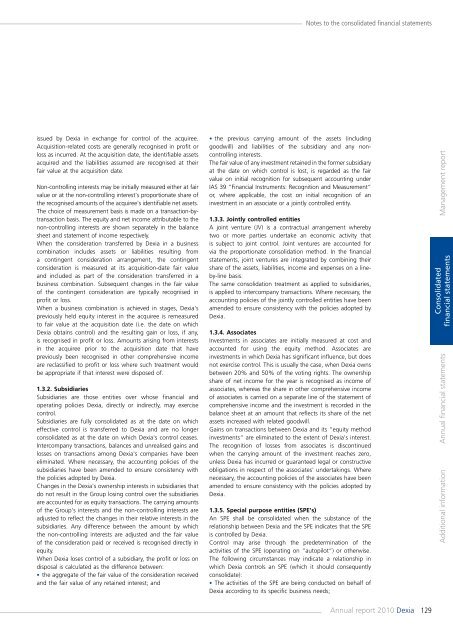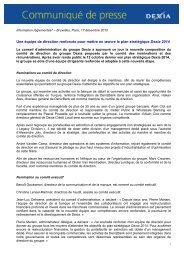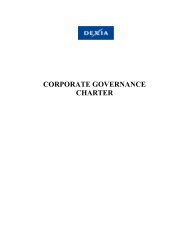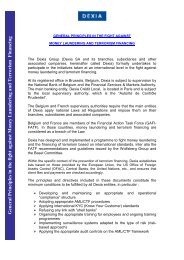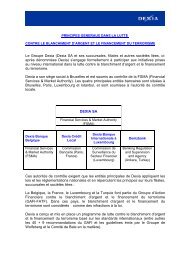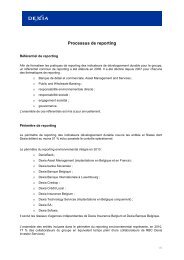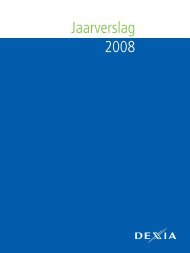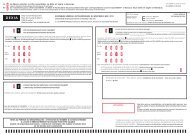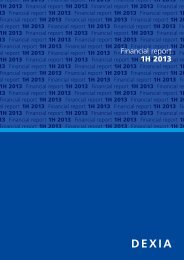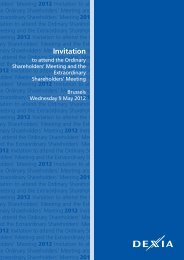Annual report 2010 - Dexia.com
Annual report 2010 - Dexia.com
Annual report 2010 - Dexia.com
- No tags were found...
Create successful ePaper yourself
Turn your PDF publications into a flip-book with our unique Google optimized e-Paper software.
Notes to the consolidated financial statementsissued by <strong>Dexia</strong> in exchange for control of the acquiree.Acquisition-related costs are generally recognised in profit orloss as incurred. At the acquisition date, the identifiable assetsacquired and the liabilities assumed are recognised at theirfair value at the acquisition date.Non-controlling interests may be initially measured either at fairvalue or at the non-controlling interest's proportionate share ofthe recognised amounts of the acquiree's identifiable net assets.The choice of measurement basis is made on a transaction-bytransactionbasis. The equity and net in<strong>com</strong>e attributable to thenon-controlling interests are shown separately in the balancesheet and statement of in<strong>com</strong>e respectively.When the consideration transferred by <strong>Dexia</strong> in a business<strong>com</strong>bination includes assets or liabilities resulting froma contingent consideration arrangement, the contingentconsideration is measured at its acquisition-date fair valueand included as part of the consideration transferred in abusiness <strong>com</strong>bination. Subsequent changes in the fair valueof the contingent consideration are typically recognised inprofit or loss.When a business <strong>com</strong>bination is achieved in stages, <strong>Dexia</strong>'spreviously held equity interest in the acquiree is remeasuredto fair value at the acquisition date (i.e. the date on which<strong>Dexia</strong> obtains control) and the resulting gain or loss, if any,is recognised in profit or loss. Amounts arising from interestsin the acquiree prior to the acquisition date that havepreviously been recognised in other <strong>com</strong>prehensive in<strong>com</strong>eare reclassified to profit or loss where such treatment wouldbe appropriate if that interest were disposed of.1.3.2. SubsidiariesSubsidiaries are those entities over whose financial andoperating policies <strong>Dexia</strong>, directly or indirectly, may exercisecontrol.Subsidiaries are fully consolidated as at the date on whicheffective control is transferred to <strong>Dexia</strong> and are no longerconsolidated as at the date on which <strong>Dexia</strong>'s control ceases.Inter<strong>com</strong>pany transactions, balances and unrealised gains andlosses on transactions among <strong>Dexia</strong>'s <strong>com</strong>panies have beeneliminated. Where necessary, the accounting policies of thesubsidiaries have been amended to ensure consistency withthe policies adopted by <strong>Dexia</strong>.Changes in the <strong>Dexia</strong>'s ownership interests in subsidiaries thatdo not result in the Group losing control over the subsidiariesare accounted for as equity transactions. The carrying amountsof the Group's interests and the non-controlling interests areadjusted to reflect the changes in their relative interests in thesubsidiaries. Any difference between the amount by whichthe non-controlling interests are adjusted and the fair valueof the consideration paid or received is recognised directly inequity.When <strong>Dexia</strong> loses control of a subsidiary, the profit or loss ondisposal is calculated as the difference between:• the aggregate of the fair value of the consideration receivedand the fair value of any retained interest; and• the previous carrying amount of the assets (includinggoodwill) and liabilities of the subsidiary and any noncontrollinginterests.The fair value of any investment retained in the former subsidiaryat the date on which control is lost, is regarded as the fairvalue on initial recognition for subsequent accounting underIAS 39 “Financial Instruments: Recognition and Measurement“or, where applicable, the cost on initial recognition of aninvestment in an associate or a jointly controlled entity.1.3.3. Jointly controlled entitiesA joint venture (JV) is a contractual arrangement wherebytwo or more parties undertake an economic activity thatis subject to joint control. Joint ventures are accounted forvia the proportionate consolidation method. In the financialstatements, joint ventures are integrated by <strong>com</strong>bining theirshare of the assets, liabilities, in<strong>com</strong>e and expenses on a lineby-linebasis.The same consolidation treatment as applied to subsidiaries,is applied to inter<strong>com</strong>pany transactions. Where necessary, theaccounting policies of the jointly controlled entities have beenamended to ensure consistency with the policies adopted by<strong>Dexia</strong>.1.3.4. AssociatesInvestments in associates are initially measured at cost andaccounted for using the equity method. Associates areinvestments in which <strong>Dexia</strong> has significant influence, but doesnot exercise control. This is usually the case, when <strong>Dexia</strong> ownsbetween 20% and 50% of the voting rights. The ownershipshare of net in<strong>com</strong>e for the year is recognised as in<strong>com</strong>e ofassociates, whereas the share in other <strong>com</strong>prehensive in<strong>com</strong>eof associates is carried on a separate line of the statement of<strong>com</strong>prehensive in<strong>com</strong>e and the investment is recorded in thebalance sheet at an amount that reflects its share of the netassets increased with related goodwill.Gains on transactions between <strong>Dexia</strong> and its “equity methodinvestments“ are eliminated to the extent of <strong>Dexia</strong>'s interest.The recognition of losses from associates is discontinuedwhen the carrying amount of the investment reaches zero,unless <strong>Dexia</strong> has incurred or guaranteed legal or constructiveobligations in respect of the associates' undertakings. Wherenecessary, the accounting policies of the associates have beenamended to ensure consistency with the policies adopted by<strong>Dexia</strong>.1.3.5. Special purpose entities (SPE's)An SPE shall be consolidated when the substance of therelationship between <strong>Dexia</strong> and the SPE indicates that the SPEis controlled by <strong>Dexia</strong>.Control may arise through the predetermination of theactivities of the SPE (operating on “autopilot“) or otherwise.The following circumstances may indicate a relationship inwhich <strong>Dexia</strong> controls an SPE (which it should consequentlyconsolidate):• The activities of the SPE are being conducted on behalf of<strong>Dexia</strong> according to its specific business needs;Management <strong>report</strong>Consolidatedfinancial statementsAdditional information <strong>Annual</strong> financial statements<strong>Annual</strong> <strong>report</strong> <strong>2010</strong> <strong>Dexia</strong>129


